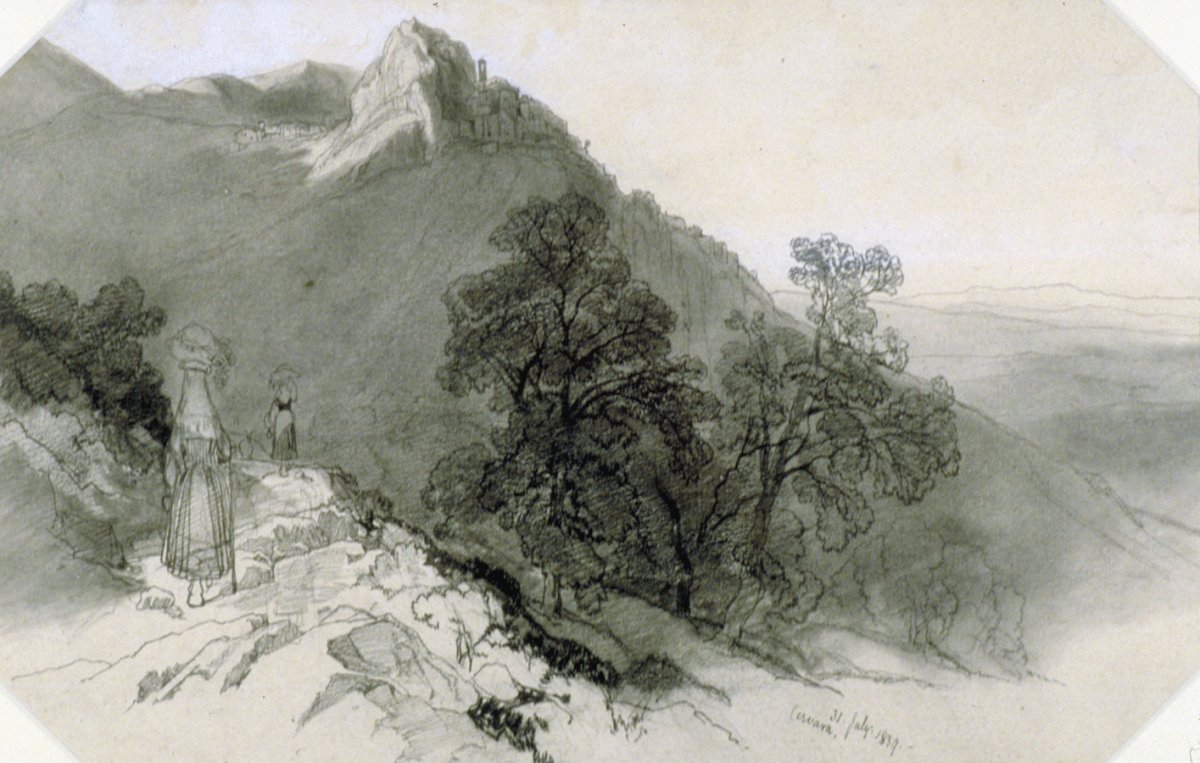Cervara, 31 July 1839
Pencil, pen and ink and sepia wash on paper
31 July 1839
-
About the work
- Location
-
Country: Holy See
City: Vatican City
Place: British Embassy
At the beginning of the volume of lithographs, Lear describes Cervara, which is about forty miles from Rome:
‘The town is built on one of the very high ranges of mountains between Tivoli and Subiaco; the ascent to it is painfully long; and from its being overlooked on one side by huge rocks and higher hills, the view from its summit is more circumscribed than one would be led to suppose. Shaded by high rocks, from the east, till the sky is high in the heavens, Cervara is the last town of these mountains that is crimsoned by the Western light. Its people wear a costume peculiar to themselves, and the Cervarese woman, with her blue gown, crimson stockings, and high heeled shoes, is easily recognized at fairs and markets, amongst all her sisters and fair country women. Cervara is one of the eighteen towns dependent on the Abbacy of Subiaco and is a place too formidable, from its remote situation, to be often visited by strangers’.
Located 30 miles from the capital, Cervara di Roma was founded by Benedictine monks in the 8th or 9th century. It is also known as the land of artists.
In the 1980s Cervara di Roma became the so-called ‘town carved in the rock’, where artists created a real open-air museum. Since 1991, the Scalinata della Pace has become the ‘Mountain of Europe’ dedicated to Peace.
-
About the artist
Edward Lear, best known for nonsense verse and limericks, was also a topographical landscape painter, musician, travel writer, ornithological and natural history draughtsman and an illustrator. Largely self-taught as a painter, he began by drawing animals at Knowsley Hall menagerie; later moving to landscape painting. He lived in Italy from 1837 to 1848, returning briefly when Queen Victoria requested twelve drawing lessons. He later studied at the Royal Academy Schools (1850-51). In 1852 he was introduced to William Holman Hunt, whose paintings became a great influence. From the early 1860s, Lear’s reputation as a landscape painter declined, perhaps partly a result of the mass-produced watercolours he made, which he called ‘Tyrants’.
-
Explore
- Places
- Subjects
- Materials & Techniques
-
Details
- Artist
-
Edward Lear (1812 - 1888)
- Title
- Cervara, 31 July 1839
- Date
- 31 July 1839
- Medium
- Pencil, pen and ink and sepia wash on paper
- Dimensions
- height: 26.50 cm, width: 41.50 cm
- Acquisition
- Purchased from Agnew, April 1952
- Inscription
- D&Insbr
- GAC number
- 1441